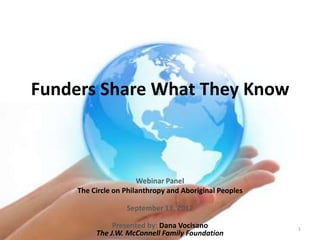
Approaching Foundations
- 1. Funders Share What They Know Webinar Panel The Circle on Philanthropy and Aboriginal Peoples September 13, 2012 Presented by: Dana Vocisano 1 The J.W. McConnell Family Foundation
- 2. TIPS FOR APPROACHING FOUNDATIONS SOME RESOURCES 2
- 3. About foundations Foundations funders are different from government funders. And there are different foundations: • Public foundation, like Trillium foundation • Community foundations, like the Vancouver Foundation • Corporate foundations • Private and family foundations • Non-granting making foundations or foundations dedicated to fundraising, like hospital foundations What their interests are and how each of them work is different. 3
- 4. Like a job search Tips for approaching foundations Similar to a job search and tailoring your CV Do your homework • Find out what they fund and how they work • Easiest way is the internet – many now have web sites How to present your work • short and dynamic • bring your work alive with stories • lots of eyes 4
- 5. Other Advice • Do your homework. Make sure you know the funder inside out: their mission, goals etc. • Ensure applications are written clearly and concisely. • Don't include extraneous information or forms not asked for. • Follow instructions. If a question allocates a certain amount of space or words, for example, stick to it. Be respectful of the funder's time. • Pretend you're an assessor when reviewing your own application to ensure you've addressed the criteria as would be expected. • Demonstrate your organization capacity, that you're able to do this project. To help solidify this point, identify your other successes. • Show your willingness to learn from and engage with community partners and share that learning. • Proofread the application before sending. • Make sure to double and triple-check your math. • Whatever you do, do not send in applications as part of a mass mailing. Sourced from: Charity Village Foundations: The inside scoop by Elisa Birnbaum, April 2, 2012 5
- 6. Life cycle of a program Many foundations are interested only in specific areas, like environment, health or education. Or only in a specific geographic area Others may only consider projects that are at a specific stage in their development. 6
- 7. Life cycle of a program • Exploration phase: trying out different ways, models, etc. • Start-up phase: implement, test & evaluate • Development phase: grow & strengthen • Scaling phase: spreading the innovation 7
- 8. Why don’t foundations fund operations? • What’s the problem with requests for operations or on-going funding? • Why don’t foundations give operating grants? 8
- 9. What’s the difference? • It’s like your chequeing bank account vs your saving bank account; one is for paying your living expenses and the other for big or special purchases • The difference between a United Way and a community foundation and how they complement each other 9
- 10. Funding for R & D • In this way, McConnell is like many other foundations – we don’t make operating grants • We see ourselves as funding R & D vs “keeping the lights on” or supporting regular on-going programs and services • For experimenting or trying something new or different that a regular budget usually is too retrained to do 10
- 11. A foundation’s niche We try to be strategic – that is, focus on an area where we can create change or have an impact 11
- 12. For example: • McConnell Foundation is interested in social innovation - new solutions to old problems • tackling chronic and persistent problems in new ways or with new combinations of ideas or practices • For example, an innovation may be introducing a better service delivery model • Has potential to lead to wider or large-scale change • We are particularly interested in social innovations that can spread and scale because the McConnell Foundation is a national funder • We recently launched a new program, with specific application criteria – The Social Innovation Fund 12
- 13. Some Other Resources to Share 13
- 14. Getting to Maybe: How the World Is Changed Frances Westley, Michael Quinn Patton, Brenda Zimmerman, 2007 14
- 15. 15
- 16. 16